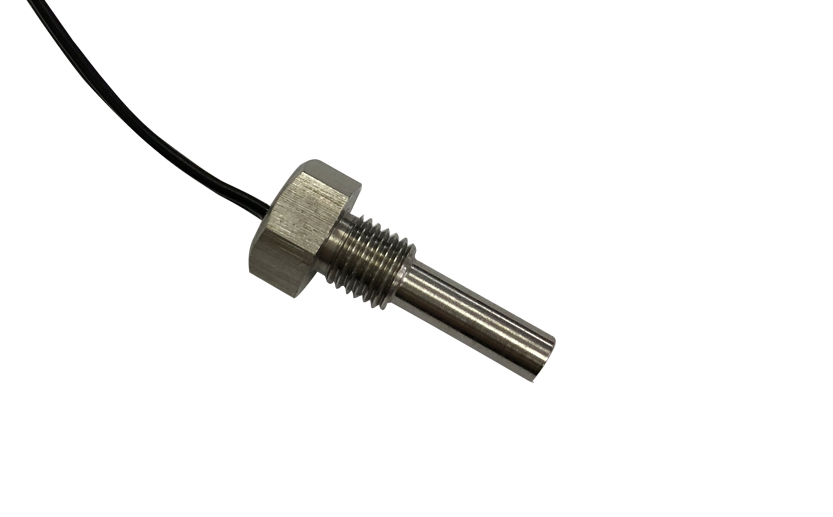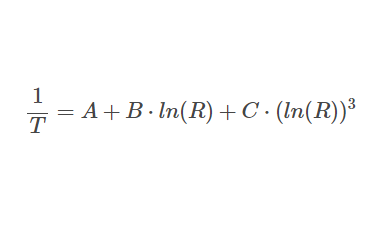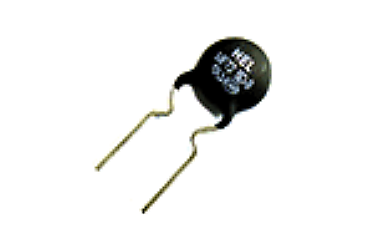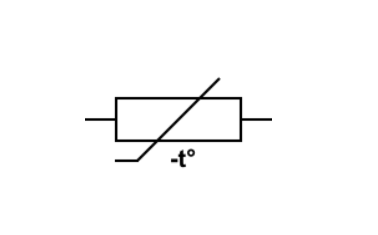
 What is NTC thermistor resistance?
What is NTC thermistor resistance?
NTC represents "negative temperature coefficient ". NTC thermistor is a resistor with negative temperature coefficient , that is, the resistance decreases with the increase in temperature. They are mainly used as resistance temperature sensors and current limit device. The temperature sensitivity coefficient is about five times larger than the silicon temperature sensor (Silistors), about ten times larger than the resistor temperature detector (RTD). NTC sensors are usually used in the range of -55 to +200 ° C.
NTC resistors The non -linearity of the resistance and temperature relationship of the resistor and temperature has a great challenge to accurately measure the temperature using analog circuit. However, the rapid development of digital circuits calculates the accuracy value through an internal intermodation table or solving the equation similar to the typical NTC curve, thereby solving this problem.
NTC thermistor definition
NTC thermistor is a thermistor. As the core temperature of the resistor increases within the operating temperature range, its resistance will show a large, accurate and predictable decline.
NTC thermistor's characteristics
Unlike the RTD (resistor temperature detector) made of metal, NTC thermistor is usually made of ceramics or polymer. Different materials used to manufacture NTC thermistor can cause different temperature response and other different performance characteristics.
Temperature response
Most NTC thermistor is usually suitable for use within the temperature range of -55 to 200 ° C, where they will provide the most accurate reading. There are some special NTC thermal resistance series that can be used at the temperature close to absolute zero (-273.15 ° C), and there are also temperature designed for temperature above 150 ° C.
The temperature sensitivity of the NTC sensor is "percentage changes per degree of degrees Celsius" or "percentage change per degree of K". According to the specific situation of the materials and production processes, the typical value range of temperature sensitivity is -3%to -6%/° C.

It can be seen from the figure that, compared with the platinum alloy RTD, the NTC thermistor has a steep resistance temperature slope, which means better temperature sensitivity. Even so, RTD is still the most accurate sensor. Its accuracy is ± 0.5%of the measurement temperature, and they are very useful in the temperature range of -200 to 800 ° C, wider than the NTC temperature sensor.
Comparison with other temperature sensors
Compared with RTD, NTC thermistor has smaller size, faster response, stronger impact and vibration capacity, and the cost is lower. Their accuracy is slightly lower than RTD. The accuracy of NTC thermistor is similar to thermocouple . However, thermocouples can withstand very high temperatures (about 600 ° C), and instead of NTC thermistor in these applications. Even so, NTC thermistor provides higher sensitivity, stability, and accuracy than thermocouple at lower temperatures, and has less additional circuits used, so the total cost is lower. Because the signal conditioning circuit (amplifier, level converter, etc.) often required when RTD is not required, the thermocouple always needs these circuits, so the cost is further reduced.
Self -heating effect
The self -heating effect is a phenomenon that will occur as long as the current flows over NTC thermistor. Because the thermal resistance is basically a resistor, when the current is over, it will dissipate power in the form of heat. This heat generates the accuracy of the measurement in the thermistor core and affects the measurement. The degree of this situation depends on the current flow, the environment (whether it is liquid or the gas, whether there is any flow on the NTC sensor, etc.), the temperature coefficients of thermistor, the total area of the thermistor, and the total area of the thermistor. The resistance of the NTC sensor and the current through its current depends on the fact that the environment is usually used in a detector in the liquid, such as a detector in a storage tank.
Hot capacity
The heat capacity indicates that the temperature required to increase the temperature of the thermistor by 1 ° C is usually represented by MJ/° C. When using NTC thermistor sensor as a surge current limit device, it is very important to understand the precise thermal capacity because it defines the response speed of the NTC temperature sensor.
Curve selection and calculation
The selection process of thermal resistance must be taken into account the most important factor of the dissipation constant, thermal time constant, resistance value, resistance-temperature curve and tolerance of thermistor.
Because the relationship between resistance and temperature (RT curve) is highly non -linear, some approximation values must be used in actual system design.
The first level is similar
A similar and the simplest use, it is the first level, it pointed out:
Δr = k mber
K is a negative temperature coefficient, Δt is temperature difference, and ΔR is a resistance change caused by temperature changes. This first -order is similar to the very narrow temperature range, and can only be used for almost the almost constant temperature in the entire temperature range.
Test formula
Another equation gives satisfactory results, accurately to ± 1 ° C within the range of 0 to +100 ° C. It depends on the single material constant β that can be obtained by measuring. The equation can be written as:

Among them, R (T) is a resistor under the temperature T, the unit is Kelvin, and the R (T 0) is the reference point for temperature T 0. The Beta formula requires two points of calibration, and its accuracy is usually not more than ± 5 ° C throughout the available range of NTC thermistor.
Stanhart Hart equation
The best approximation value known so far is the Steinhart-Hart formula, published in 1968:

Among them, the LN R is the natural number of the resistance of the under -temperature temperature T resistance, and A, B, and C are the coefficient measured from the experiment. These coefficients are usually published by the thermistor supplier as part of the data table. The Steinhart -Hart formula is usually accurately about ± 0.15 ° C within the range of -50 to +150 ° C, which is enough for most applications. If higher accuracy is required, the temperature range must be reduced, and accuracy is better than ± 0.01 ° C within a range of 0 to +100 ° C.
Select the correct approximate value
The selection of formulas used to measure temperature from resistance measures requires available computing capabilities and actual deviation requirements. In some applications, the first order is approximate enough, and in other applications, even Steinhart-Hart cannot meet the requirements, and the calibration thermistor must be calibrated one by one, a large number of measurement tables are measured and the search table is created.
The structure and characteristics of the thermistor of NTC
The materials that are usually used to manufacture NTC resistors are platinum, nickel, cobalt, iron and silicon oxides, which are used as pure elements or used as ceramics and polymers. NTC thermistor can be divided into three groups according to the production process used.
bead -shaped thermistor

These NTC thermistor are made of platinum alloy leads directly sintered into the ceramic body. They usually provide fast response time, better stability, and allow them to run at higher temperatures than disks and chip NTC sensors, but they are more fragile. They are usually sealed in glass to protect them from being damaged by mechanical damage and improve their measurement stability during the assembly process. The typical size range is 0.075-5 mm diameter.
Disk -sensitive resistance

These NTC thermistor of the discs of discs have metallic surface contacts. They are larger than the bead -type NTC resistor, so the response time is slower. However, due to their size, they have higher dissipation constants (the power required to increase the temperature by 1 ° C). Because the power dispersed from the thermistor is proportional to the square of the current, they can better process a higher current than the bead -type thermistor. The discs of the discs are made by pushing the mixture of the oxide powder into the round mold, and then sintering at high temperature. The chip is usually manufactured by the flow process, which is carried out as a thick film, drying and cutting shape. The typical size range is 0.25 to 25 mm diameter.
The NTC thermistor of the glass packaged

These are the NTC temperature sensors sealed in seal glass bubbles. They are designed for temperatures above 150 ° C, or for printing circuit board installation. The solid is necessary. The thermist resistance packaging can improve the stability of the sensor in the glass and protect the sensor from environmental impact. They are made by sealing the bead -type NTC resistor in the glass container. The typical size range is 0.4 to 10 mm diameter.
Typical Application
NTC thermistor is used for widespread application. They are used to measure temperature, control temperature and compensation temperature. They can also be used to detect whether the liquid exists, as a current -limiting device in the power circuit, for temperature monitoring in automotive applications, and more applications. According to the electrical characteristics used in the application, the NTC sensor can be divided into three groups.
resistance temperature characteristics
Applications based on resistance temperature characteristics include temperature measurement, control and compensation. These also include the use of NTC thermistor to be related to the temperature of the NTC temperature sensor and some other physical phenomena. This set of applications requires thermistor to run under zero -power conditions, which means that it is kept as low as possible through its current to avoid heating probes.
current time characteristics
Applications based on current-time characteristics include: delay, surge current restrictions, surge suppression, etc. These characteristics are related to the thermal capacity and dissipation constant of the NTC thermistor. The circuit usually relies on NTC thermal resistance to heat up due to its current. At a certain moment, it triggers a certain change in the circuit, depending on its application.
voltage-current characteristics
Applications based on thermistor voltage-current characteristics usually involve changes in environmental conditions or circuit changes, which will cause changes in working points on the radical curve in the circuit. According to the application, this can be used for current limit, temperature compensation or temperature measurement.
NTC thermal resistance symbol
According to the IEC standard, the following symbols are used for negative temperature coefficient thermistor.

NTC thermistor (IEC standard)

